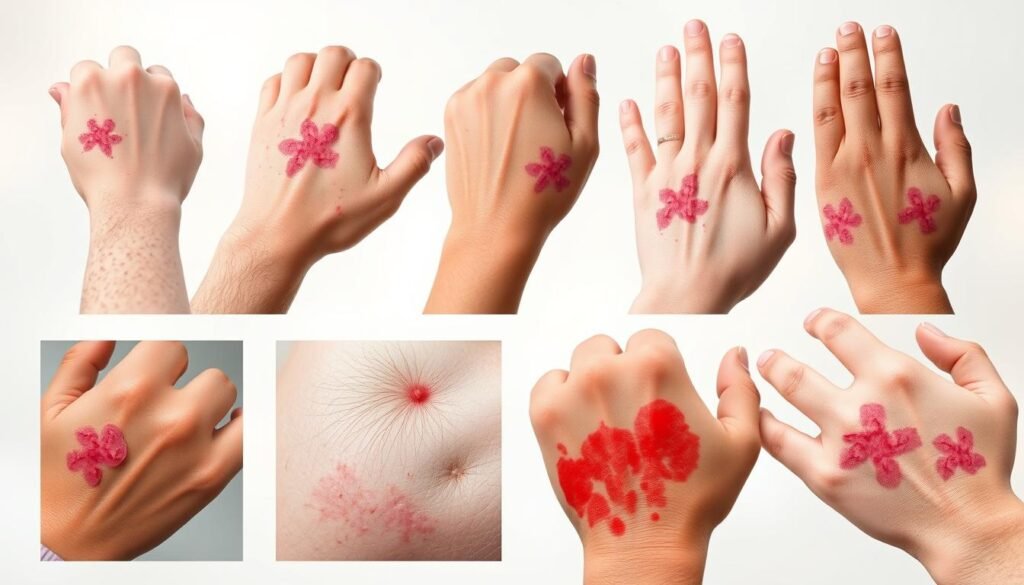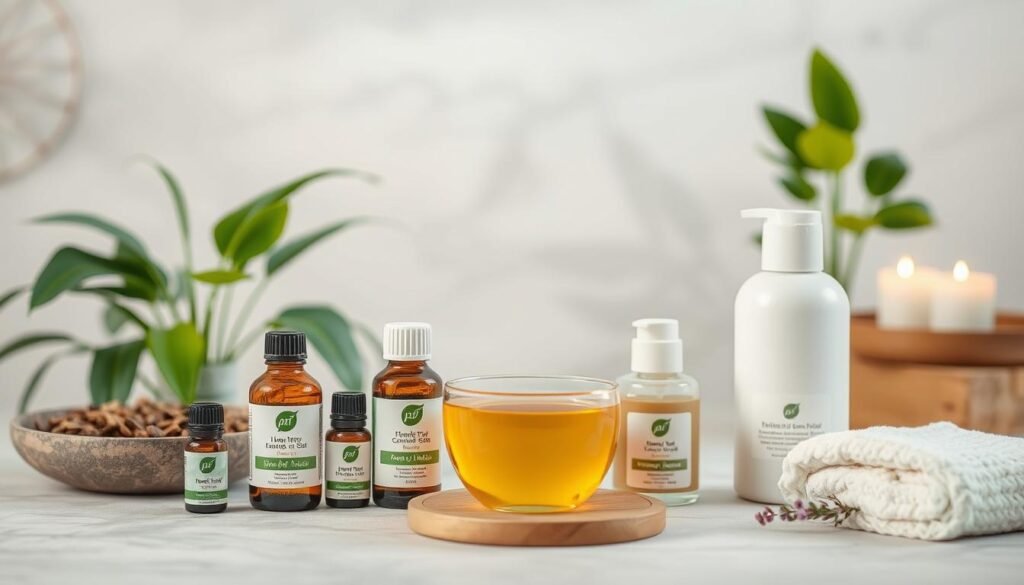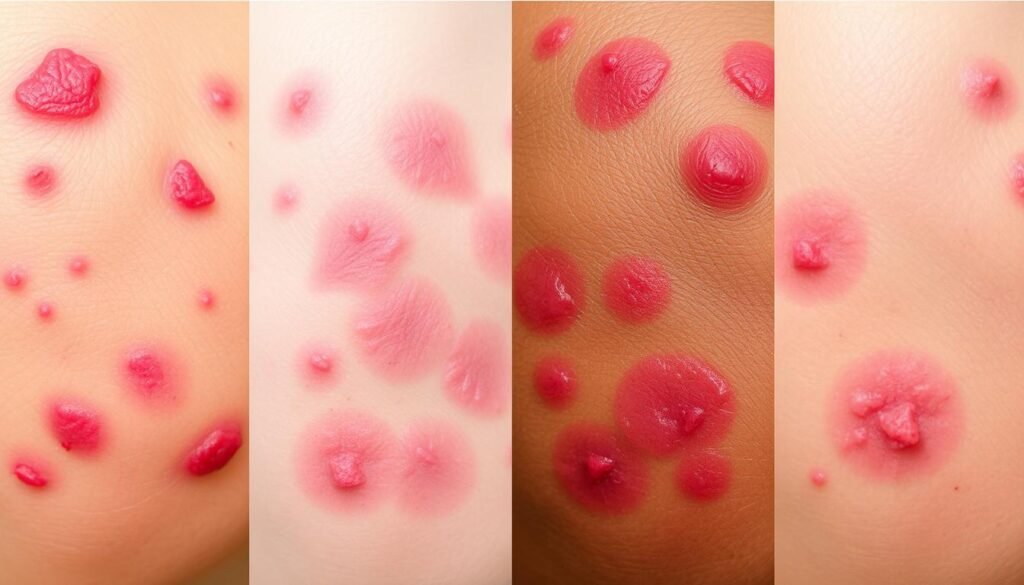Up to 30% of people visiting dermatologists have skin problems related to their emotions. This link between mental and skin health is often ignored. Skin conditions triggered by anxiety include itchy hives and inflamed eczema.
This article is a visual guide. It helps identify and understand rashes caused by anxiety and stress. Recognizing these symptoms lets people manage their skin better. They can also tackle the emotions behind these rashes. Check out this visual resource for more on skin rashes, including pictures and descriptions.
Key Takeaways
- Up to 30% of dermatology patients might experience skin issues linked to anxiety.
- Effective management requires understanding both physical and emotional triggers.
- Various rashes like hives and eczema can be stress-induced.
- Topical treatments and lifestyle changes can alleviate symptoms.
- Developing a personalized skincare routine is crucial for anxiety-prone skin.
Understanding Anxiety and Its Physical Manifestations
Anxiety affects about 32% of people in the U.S. Roughly half of those aged 18–24 show signs of it. It influences both mental and physical health. Anxiety often leads to skin problems, including rashes.
Women between 30 and 40 are more likely to get these skin issues, nearly twice as much as men. Stress can make the body release histamine, causing rashes. These rashes, or hives, can appear anywhere and might join to form bigger areas.
If hives last for more than 24 hours, they usually go away on their own. However, if they stay for over six weeks, see a doctor.
Making good life choices helps manage anxiety. Eating well, sleeping enough, and staying active can lower anxiety. It might also stop these skin rashes. It’s vital to know the difference between anxiety rashes and other skin problems.
Knowing how anxiety and its physical effects are linked helps treat both the mind and skin.
The Mind-Body Connection and Skin Health
The mind-body connection rash shows how our feelings directly impact our skin health. Many skin issues actually reflect our emotional stress. This reveals a deep link between how we feel mentally and how our skin looks. Psychodermatology studies this bond, focusing on how mental states can cause skin problems.
Stress can make skin problems like hives, eczema, and rosacea worse. When we’re anxious, our body releases hormones that can inflame the skin. This can lead to rashes or other issues linked to how stressed we feel.
It’s crucial to address how emotions affect our skin when managing skin diseases. These conditions can tell us a lot about someone’s mental health. Understanding that the mind can influence our skin’s health is important. It affects our immune system and can cause inflammation.
To manage skin issues tied to mental factors, we need to tackle stress and anxiety. Improving mental health can help heal our skin. Using both skin treatments and therapy is key. This shows the power of the mind-body connection rash.
Learning how stress impacts our body is beneficial. It’s advised to dig deeper into how our feelings affect our skin. Experts suggest checking out resources like physical symptoms of anxiety.
Anxiety Stress Rash Pictures: Recognizing the Symptoms
Knowing how to spot an anxiety stress rash is key for quick help. People with stress hives see clear signs on their skin. Pictures help a lot in knowing what to look for. Common symptoms tell us about our emotional well-being.
What Does an Anxiety Stress Rash Look Like?
Anxiety stress rashes look like raised welts, changing in size and color. These rashes might be red, dark, or purple, and feel itchy or like they’re burning. Pictures make it easier to understand what these symptoms mean.
Common Symptoms Associated with Anxiety-Induced Hives
- Raised, discolored bumps (hives) on various body parts including the face, chest, neck, and arms
- Itchiness or a tingling sensation
- Variations in size, from small spots to large welts
- Potential swelling that may extend to surrounding areas
Emotional triggers might cause extra symptoms. It’s important to notice these early. Doing so helps avoid worse skin problems. Quick detection leads to better handling.
| Symptom | Description |
|---|---|
| Itching | A strong desire to scratch the affected area, often worsening the condition. |
| Burning Sensation | A feeling of warmth or discomfort on the skin, prompting further irritation. |
| Raised Hives | Swollen areas of skin that appear higher than the surrounding skin, usually red or dark. |
| Diverse Sizes | Hives may range from a few millimeters to several inches, appearing individually or in clusters. |
Being aware of these signs helps people take quick action and get needed help. Tackling the emotional sides of anxiety stress helps in healing both mind and body.
Types of Rashes Caused by Anxiety and Stress
When you feel anxious or stressed, your skin can show it by developing rashes. Different types of skin conditions can arise because of these feelings. Each comes with its own set of symptoms that stress can make worse. Knowing about these can help you take care of an anxiety-induced rash.
Hives (Urticaria)
One common stress-related skin problem is hives, also known as urticaria. Stress can cause your body to release histamines. This results in itchy red bumps on your skin. These bumps can be of various sizes and show up anywhere like your neck, face, arms, or chest. They usually go away after a few hours or days. But, if you notice hives sticking around longer, it might mean you have a chronic issue.
Atopic Dermatitis (Eczema)
Another skin condition linked to anxiety is atopic dermatitis, which you might know as eczema. During stressful times, your skin might get inflamed, itchy, and red. This shows how your body reacts to stress. Eczema often looks like patches. To manage it, you might need moisturizers and medications. This helps keep symptoms in check and prevents further episodes.
Contact Dermatitis
Contact dermatitis happens when your skin reacts badly to certain things because of stress. These could be soaps, cosmetics, or even metals. If you’re already feeling anxious, your skin might become more sensitive. This leads to rashes and discomfort. Knowing what triggers your skin and staying away from it is key to managing contact dermatitis.

| Type of Rash | Characteristics | Common Triggers |
|---|---|---|
| Hives (Urticaria) | Itchy, red bumps; varies in size; can appear anywhere | Stress, allergens, medications |
| Atopic Dermatitis (Eczema) | Patches of irritated skin; dry and itchy | Stress, environmental factors, allergens |
| Contact Dermatitis | Red, itchy rash; response to irritants | Soaps, cosmetics, metals |
Triggers of Anxiety-Induced Skin Conditions
Knowing what triggers anxiety-induced skin conditions is key. Triggers include emotional and environmental factors, plus common allergens and irritants. The way anxiety stress rash triggers interact with our bodies shows the complexity of anxiety-related skin conditions.
Emotional Triggers
Emotional triggers can cause skin conditions. Situations like deadlines or conflicts can worsen with anxiety. This can lead to environmental anxiety rash. Chronic anxiety also makes our bodies react more strongly under stress, raising the chance of skin issues.
Environmental Factors
Environmental elements significantly impact anxiety stress rash. Rough weather or high humidity can irritate our skin. This can make anxiety worse and lead to rashes. Stressful jobs can increase these effects. Recognizing these triggers can help in managing them better.
Allergens and Irritants
Allergens and irritants can make anxiety-related skin conditions worse. Dust, pollen, and some foods might cause hives or rashes. Knowing what triggers your allergies is important. It helps in avoiding or reducing the impact of these triggers on your skin.
| Trigger Type | Examples | Effects on Skin |
|---|---|---|
| Emotional Triggers | Work stress, relationship issues, financial problems | Increased sensitivity, anxiety stress rash triggers |
| Environmental Factors | Weather changes, humidity, stressful work environments | Development of environmental anxiety rash |
| Allergens and Irritants | Dust, pollen, certain foods, harsh skincare products | Exacerbation of emotional trigger skin conditions |
Psychodermatology: The Intersection of Psychology and Dermatology
Psychodermatology is a growing field that links psychological well-being to skin health. Studies show that about 85% of people seeing a dermatologist also face psychological challenges. This shows how emotions play a big role in skin health.
Stress has a clear impact on skin disorders. Conditions like eczema, acne, and psoriasis can get worse due to stress. In fact, stress triggers as many as 80% of psoriasis cases. This creates a tough cycle of stress, itching, and poor sleep, harming both skin and overall well-being.
Treatments that combine psychological help with skin care show great promise. For example, using cognitive-behavioral therapy (CBT) alongside medications for psoriasis works better than medication alone. This approach underscores the need to care for both mind and skin for real improvement.
Understanding different types of psychodermatologic disorders is key to effective care. As the link between mind and skin gains more attention, patients can receive holistic care. This approach addresses both their mental and skin health needs.
Diagnostic Approach to Anxiety-Induced Rashes
To identify anxiety-induced skin problems, a deep look into the patient’s health history is needed. Doctors start by learning about the patient’s symptoms and their stress levels. This helps them spot patterns linking stress to skin issues.
In examining the patient, they search for signs like hives – raised, itchy spots on the skin. The treatment plan depends largely on these early findings. Sometimes, more tests like skin biopsies or blood work are needed. These help rule out other health conditions when the cause isn’t clear.
Understanding a patient’s mental health is key. It’s important because stress can make skin issues worse. This means treatments need to consider both the patient’s mind and body. Such an approach shows how our emotions can affect our skin, highlighting the importance of looking at the whole picture.
Treatment Options for Anxiety-Related Skin Conditions
Anxiety-related skin issues can be treated in many ways. It’s important to know what treatments are out there. This is especially true for those dealing with stress rashes. Treatments include over-the-counter remedies, prescription drugs, and methods like mindfulness.
Over-the-Counter Treatments
There are many remedies you can buy without a prescription for anxiety rash. They help with mild to moderate symptoms. You can find:
- Antihistamines – Products like diphenhydramine (Benadryl) lessen itching and swelling.
- Corticosteroid creams – These creams, like hydrocortisone, reduce redness and swelling.
- Calamine lotion – It cools the skin and cuts down on itching.
- Moisturizers – Unscented moisturizers keep the skin barrier strong, avoiding more irritation.
Prescription Medications
If the skin condition is worse, doctors might suggest prescription meds. Your options are:
- Stronger corticosteroids – These are for ongoing inflammation.
- Oral antihistamines – Pills like cetirizine (Zyrtec) offer lasting itch relief.
- Antidepressants – These can help both your anxiety and your skin.
- Antibiotics – Needed if scratching leads to infection.
Mindfulness and Stress Management Techniques
Managing skin problems from anxiety includes mindful and stress-reducing practices. You might try:
- Meditation – It helps deal with anxiety, which reduces skin issues.
- Yoga – This combines physical and mental relaxation.
- Breathing exercises – These are quick ways to handle stress.
- Cognitive-behavioral therapy – It changes negative thoughts tied to anxiety.

Mixing these treatments can greatly help manage skin conditions caused by anxiety. Having a routine that includes medical and stress reduction strategies leads to healthy skin and emotional balance.
| Treatment Type | Examples | Benefits |
|---|---|---|
| Over-the-Counter | Antihistamines, Corticosteroid creams, Calamine lotion | Immediate relief from itching and redness |
| Prescription Medications | Stronger corticosteroids, Oral antihistamines, Antidepressants | Addressing severe symptoms and the underlying anxiety |
| Holistic Approaches | Meditation, Yoga, Cognitive-behavioral therapy | Lowering overall anxiety and bettering skin health |
Real-Life Experiences: Personal Stories on Anxiety Stress Rashes
Many people talk about how stress shows up as a rash on their skin. These anxiety rashes are more than just skin deep. They tell a story of emotional struggles. Folks with these rashes often share their stories to feel connected with others in similar situations.
The link between stress and skin is a big part of these stories. When anxiety goes up, so do reactions like hives. Many say these skin problems come out of nowhere, affecting daily life and confidence. They also note that managing stress leads to fewer rashes. This shows how closely our minds and skin are connected.
Having a good support system is crucial. Kind words from friends and family help a lot during tough times. Stories also tell of finding calm in yoga or meditation. This helps heal both their minds and their skin.
Here are some insights from their stories:
- Stress rashes often start during big life changes.
- Living healthier, with more sleep and exercise, can make skin issues less frequent and severe.
- Dealing with chronic hives impacts how you look, your personal life, and work too.
Learning from these experiences can make us more understanding. It shows us the hard parts of dealing with stress and skin issues. But it also celebrates the strong spirit of those dealing with it.
Images and Visual References for Identification
A rich collection of visual references for anxiety rashes helps us recognize skin issues. These images show how rashes look on different people. They make it easier to talk about skin health by offering detailed identification of skin conditions images.
Take hives, for example. They can show up anywhere on the body. They start as raised dots and can turn into painful welts. These signs help people know if stress or anxiety is causing their symptoms.
Eczema often appears on elbows, hands, and in skin folds. Looking at pictures of eczema helps spot the difference between it and other skin issues. You can learn more from resources on skin conditions.
Seeing what poison ivy rashes look like is also useful. The rash usually shows up 12 to 72 hours after touching poison ivy. It can last up to two weeks. This knowledge is key for preventing and treating the rash.

Choosing the right images helps readers link their experiences with solid info. Knowing what different rashes look like helps us talk about keeping our skin healthy. Learning how to handle stress is also important. You can find tips at practical tips for reducing anxiety.
Conclusion
Anxiety and skin health are closely linked. This shows the need for careful attention to both mental and skin health. If you face anxiety-related skin issues, it’s important to get help from experts. Dermatologists can provide treatments that do more than just ease symptoms.
Managing anxiety is key to keeping your skin healthy. Techniques like deep breathing, meditation, and eating foods that fight inflammation help a lot. Also, using medicines such as antihistamines or creams can ease discomfort. For more advice, check out diagnosis and treatment options.
Understanding the link between your mind and body is vital for better health. Taking steps to lower anxiety can lead to clearer skin and a calmer mind. The journey might be tough, but with the right help and steps, you can make great progress.